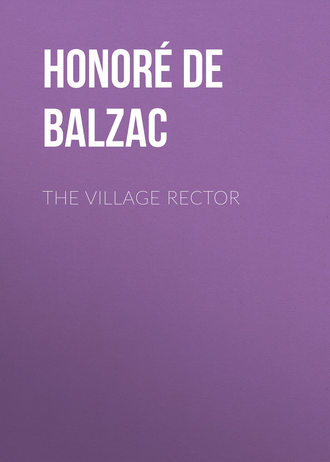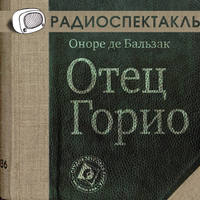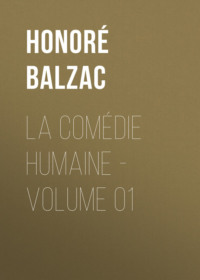 полная версия
полная версияThe Village Rector

Honoré de Balzac
The Village Rector
DEDICATION
To Helene.
The tiniest boat is not launched upon the sea without the protection of some living emblem or revered name, placed upon it by the mariners. In accordance with this time-honored custom, Madame, I pray you to be the protectress of this book now launched upon our literary ocean; and may the Imperial name which the Church has canonized and your devotion has doubly sanctified for me guard it from perils.
De Balzac.I. THE SAUVIATS
In the lower town of Limoges, at the corner of the rue de la Vieille-Poste and the rue de la Cite might have been seen, a generation ago, one of those shops which were scarcely changed from the period of the middle-ages. Large tiles seamed with a thousand cracks lay on the soil itself, which was damp in places, and would have tripped up those who failed to observe the hollows and ridges of this singular flooring. The dusty walls exhibited a curious mosaic of wood and brick, stones and iron, welded together with a solidity due to time, possibly to chance. For more than a hundred years the ceiling, formed of colossal beams, bent beneath the weight of the upper stories, though it had never given way under them. Built en colombage, that is to say, with a wooden frontage, the whole facade was covered with slates, so put on as to form geometrical figures, – thus preserving a naive image of the burgher habitations of the olden time.
None of the windows, cased in wood and formerly adorned with carvings, now destroyed by the action of the weather, had continued plumb; some bobbed forward, others tipped backward, while a few seemed disposed to fall apart; all had a compost of earth, brought from heaven knows where, in the nooks and crannies hollowed by the rain, in which the spring-tide brought forth fragile flowers, timid creeping plants, and sparse herbage. Moss carpeted the roof and draped its supports. The corner pillar, with its composite masonry of stone blocks mingled with brick and pebbles, was alarming to the eye by reason of its curvature; it seemed on the point of giving way under the weight of the house, the gable of which overhung it by at least half a foot. The municipal authorities and the commissioner of highways did, eventually, pull the old building down, after buying it, to enlarge the square.
The pillar we have mentioned, placed at the angle of two streets, was a treasure to the seekers for Limousin antiquities, on account of its lovely sculptured niche in which was a Virgin, mutilated during the Revolution. All visitors with archaeological proclivities found traces of the stone sockets used to hold the candelabra in which public piety lighted tapers or placed its ex-votos and flowers.
At the farther end of the shop, a worm-eaten wooden staircase led to the two upper floors which were in turn surmounted by an attic. The house, backing against two adjoining houses, had no depth and derived all its light from the front and side windows. Each floor had two small chambers only, lighted by single windows, one looking out on the rue de la Cite, the other on the rue de la Vieille-Poste.
In the middle-ages no artisan was better lodged. The house had evidently belonged in those times to makers of halberds and battle-axes, armorers in short, artificers whose work was not injured by exposure to the open air; for it was impossible to see clearly within, unless the iron shutters were raised from each side of the building; where were also two doors, one on either side of the corner pillar, as may be seen in many shops at the corners of streets. From the sill of each door – of fine stone worn by the tread of centuries – a low wall about three feet high began; in this wall was a groove or slot, repeated above in the beam by which the wall of each facade was supported. From time immemorial the heavy shutters had been rolled along these grooves, held there by enormous iron bars, while the doors were closed and secured in the same manner; so that these merchants and artificers could bar themselves into their houses as into a fortress.
Examining the interior, which, during the first twenty years of this century, was encumbered with old iron and brass, tires of wheels, springs, bells, anything in short which the destruction of buildings afforded of old metals, persons interested in the relics of the old town noticed signs of the flue of a forge, shown by a long trail of soot, – a minor detail which confirmed the conjecture of archaeologists as to the original use to which the building was put. On the first floor (above the ground-floor) was one room and the kitchen; on the floor above that were two bedrooms. The garret was used to put away articles more choice and delicate than those that lay pell-mell about the shop.
This house, hired in the first instance, was subsequently bought by a man named Sauviat, a hawker or peddler who, from 1786 to 1793, travelled the country over a radius of a hundred and fifty miles around Auvergne, exchanging crockery of a common kind, plates, dishes, glasses, – in short, the necessary articles of the poorest households, – for old iron, brass, and lead, or any metal under any shape it might lurk in. The Auvergnat would give, for instance, a brown earthenware saucepan worth two sous for a pound of lead, two pounds of iron, a broken spade or hoe or a cracked kettle; and being invariably the judge of his own cause, he did the weighing.
At the close of his third year Sauviat added the hawking of tin and copper ware to that of his pottery. In 1793 he was able to buy a chateau sold as part of the National domain, which he at once pulled to pieces. The profits were such that he repeated the process at several points of the sphere in which he operated; later, these first successful essays gave him the idea of proposing something of a like nature on a larger scale to one of his compatriots who lived in Paris. Thus it happened that the “Bande Noire,” so celebrated for its devastations, had its birth in the brain of old Sauviat, the peddler, whom all Limoges afterward saw and knew for twenty-seven years in the rickety old shop among his cracked bells and rusty bars, chains and scales, his twisted leaden gutters, and metal rubbish of all kinds. We must do him the justice to say that he knew nothing of the celebrity or the extent of the association he originated; he profited by his own idea only in proportion to the capital he entrusted to the since famous firm of Bresac.
Tired of frequenting fairs and roaming the country, the Auvergnat settled at Limoges, where he married, in 1797, the daughter of a coppersmith, a widower, named Champagnac. When his father-in-law died he bought the house in which he had been carrying on his trade of old-iron dealer, after ceasing to roam the country as a peddler. Sauviat was fifty years of age when he married old Champagnac’s daughter, who was herself not less than thirty. Neither handsome nor pretty, she was nevertheless born in Auvergne, and the patois seemed to be the mutual attraction; also she had the sturdy frame which enables women to bear hard work. In the first three years of their married life Sauviat continued to do some peddling, and his wife accompanied him, carrying iron or lead on her back, and leading the miserable horse and cart full of crockery with which her husband plied a disguised usury. Dark-skinned, high-colored, enjoying robust health, and showing when she laughed a brilliant set of teeth, white, long, and broad as almonds, Madame Sauviat had the hips and bosom of a woman made by Nature expressly for maternity.
If this strong girl were not earlier married, the fault must be attributed to the Harpagon “no dowry” her father practised, though he never read Moliere. Sauviat was not deterred by the lack of dowry; besides, a man of fifty can’t make difficulties, not to speak of the fact that such a wife would save him the cost of a servant. He added nothing to the furniture of his bedroom where, from the day of his wedding to the day he left the house, twenty years later, there was never anything but a single four-post bed, with valance and curtains of green serge, a chest, a bureau, four chairs, a table, and a looking-glass, all collected from different localities. The chest contained in its upper section pewter plates, dishes, etc., each article dissimilar from the rest. The kitchen can be imagined from the bedroom.
Neither husband nor wife knew how to read, – a slight defect of education which did not prevent them from ciphering admirably and doing a most flourishing business. Sauviat never bought any article without the certainty of being able to sell it for one hundred per cent profit. To relieve himself of the necessity of keeping books and accounts, he bought and sold for cash only. He had, moreover, such a perfect memory that the cost of any article, were it only a farthing, remained in his mind year after year, together with its accrued interest.
Except during the time required for her household duties, Madame Sauviat was always seated in a rickety wooden chair placed against the corner pillar of the building. There she knitted and looked at the passers, watched over the old iron, sold and weighed it, and received payment if Sauviat was away making purchases. When at home the husband could be heard at daybreak pushing open his shutters; the household dog rushed out into the street; and Madame Sauviat presently came out to help her man in spreading upon the natural counter made by the low walls on either side of the corner of the house on the two streets, the multifarious collection of bells, springs, broken gunlocks, and the other rubbish of their business, which gave a poverty-stricken look to the establishment, though it usually contained as much as twenty thousand francs’ worth of lead, steel, iron, and other metals.
Never were the former peddler and his wife known to speak of their fortune; they concealed its amount as carefully as a criminal hides a crime; and for years they were suspected of shaving both gold and silver coins. When Champagnac died the Sauviats made no inventory of his property; but they rummaged, with the intelligence of rats, into every nook and corner of the old man’s house, left it as naked as a corpse, and sold the wares it contained in their own shop.
Once a year, in December, Sauviat went to Paris in one of the public conveyances. The gossips of the neighborhood concluded that in order to conceal from others the amount of his fortune, he invested it himself on these occasions. It was known later that, having been connected in his youth with one of the most celebrated dealers in metal, an Auvergnat like himself, who was living in Paris, Sauviat placed his funds with the firm of Bresac, the mainspring and spine of that famous association known by the name of the “Bande Noire,” which, as we have already said, took its rise from a suggestion made by Sauviat himself.
Sauviat was a fat little man with a weary face, endowed by Nature with a look of honesty which attracted customers and facilitated the sale of goods. His straightforward assertions, and the perfect indifference of his tone and manner, increased this impression. In person, his naturally ruddy complexion was hardly perceptible under the black metallic dust which powdered his curly black hair and the seams of a face pitted with the small-pox. His forehead was not without dignity; in fact, it resembled the well-known brow given by all painters to Saint Peter, the man of the people, the roughest, but withal the shrewdest, of the apostles. His hands were those of an indefatigable worker, – large, thick, square, and wrinkled with deep furrows. His chest was of seemingly indestructible muscularity. He never relinquished his peddler’s costume, – thick, hobnailed shoes; blue stockings knit by his wife and hidden by leather gaiters; bottle-green velveteen trousers; a checked waistcoat, from which depended the brass key of his silver watch by an iron chain which long usage had polished till it shone like steel; a jacket with short tails, also of velveteen, like that of the trousers; and around his neck a printed cotton cravat much frayed by the rubbing of his beard.
On Sundays and fete-days Sauviat wore a frock-coat of maroon cloth, so well taken care of that two new ones were all he bought in twenty years. The living of galley-slaves would be thought sumptuous in comparison with that of the Sauviats, who never ate meat except on the great festivals of the Church. Before paying out the money absolutely needed for their daily subsistence, Madame Sauviat would feel in the two pockets hidden between her gown and petticoat, and bring forth a single well-scraped coin, – a crown of six francs, or perhaps a piece of fifty-five sous, – which she would gaze at for a long time before she could bring herself to change it. As a general thing the Sauviats ate herrings, dried peas, cheese, hard eggs in salad, vegetables seasoned in the cheapest manner. Never did they lay in provisions, except perhaps a bunch of garlic or onions, which could not spoil and cost but little. The small amount of wood they burned in winter they bought of itinerant sellers day by day. By seven in winter, by nine in summer, the household was in bed, and the shop was closed and guarded by a huge dog, which got its living from the kitchens in the neighborhood. Madame Sauviat used about three francs’ worth of candles in the course of the year.
The sober, toilsome life of these persons was brightened by one joy, but that was a natural joy, and for it they made their only known outlays. In May, 1802, Madame Sauviat gave birth to a daughter. She was confined all alone, and went about her household work five days later. She nursed her child in the open air, seated as usual in her chair by the corner pillar, continuing to sell old iron while the infant sucked. Her milk cost nothing, and she let her little daughter feed on it for two years, neither of them being the worse for the long nursing.
Veronique (that was the infant’s name) became the handsomest child in the Lower town, and every one who saw her stopped to look at her. The neighbors then noticed for the first time a trace of feeling in the old Sauviats, of which they had supposed them devoid. While the wife cooked the dinner the husband held the little one, or rocked it to the tune of an Auvergnat song. The workmen as they passed sometimes saw him motionless gazing at Veronique asleep on her mother’s knees. He softened his harsh voice when he spoke to her, and wiped his hands on his trousers before taking her up. When Veronique tried to walk, the father bent his legs and stood at a little distance holding out his arms and making little grimaces which contrasted funnily with the rigid furrows of his stern, hard face. The man of iron, brass, and lead became a being of flesh and blood and bones. If he happened to be standing with his back against the corner pillar motionless, a cry from Veronique would agitate him and send him flying over the mounds of iron fragments to find her; for she spent her childhood playing with the wreck of ancient castles heaped in the depths of that old shop. There were other days on which she went to play in the street or with the neighboring children; but even then her mother’s eye was always on her.
It is not unimportant to say here that the Sauviats were eminently religious. At the very height of the Revolution they observed both Sunday and fete-days. Twice Sauviat came near having his head cut off for hearing mass from an unsworn priest. He was put in prison, being justly accused of helping a bishop, whose life he saved, to fly the country. Fortunately the old-iron dealer, who knew the ways of bolts and bars, was able to escape; nevertheless he was condemned to death by default, and as, by the bye, he never purged himself of that contempt, he may be said to have died dead.
His wife shared his piety. The avariciousness of the household yielded to the demands of religion. The old-iron dealers gave their alms punctually at the sacrament and to all the collections in church. When the vicar of Saint-Etienne called to ask help for his poor, Sauviat or his wife fetched at once without reluctance or sour faces the sum they thought their fair share of the parish duties. The mutilated Virgin on their corner pillar never failed (after 1799) to be wreathed with holly at Easter. In the summer season she was feted with bouquets kept fresh in tumblers of blue glass; this was particularly the case after the birth of Veronique. On the days of the processions the Sauviats scrupulously hung their house with sheets covered with flowers, and contributed money to the erection and adornment of the altar, which was the pride and glory of the whole square.
Veronique Sauviat was, therefore, brought up in a Christian manner. From the time she was seven years old she was taught by a Gray sister from Auvergne to whom the Sauviats had done some kindness in former times. Both husband and wife were obliging when the matter did not affect their pockets or consume their time, – like all poor folk who are cordially ready to be serviceable to others in their own way. The Gray sister taught Veronique to read and write; she also taught her the history of the people of God, the catechism, the Old and the New Testaments, and a very little arithmetic. That was all; the worthy sister thought it enough; it was in fact too much.
At nine years of age Veronique surprised the whole neighborhood with her beauty. Every one admired her face, which promised much to the pencil of artists who are always seeking a noble ideal. She was called “the Little Virgin” and showed signs already of a fine figure and great delicacy of complexion. Her Madonna-like face – for the popular voice had well named her – was surrounded by a wealth of fair hair, which brought out the purity of her features. Whoever has seen the sublime Virgin of Titian in his great picture of the “Presentation” at Venice, will know that Veronique was in her girlhood, – the same ingenuous candor, the same seraphic astonishment in her eyes, the same simple yet noble attitude, the same majesty of childhood in her demeanor.
At eleven years of age she had the small-pox, and owed her life to the care of Soeur Marthe. During the two months that their child was in danger the Sauviats betrayed to the whole community the depth of their tenderness. Sauviat no longer went about the country to sales; he stayed in the shop, going upstairs and down to his daughter’s room, sitting up with her every night in company with his wife. His silent anguish seemed so great that no one dared to speak to him; his neighbors looked at him with compassion, but they only asked news of Veronique from Soeur Marthe. During the days when the child’s danger reached a crisis, the neighbors and passers saw, for the first and only time in Sauviat’s life, tears in his eyes and rolling down his hollow cheeks; he did not wipe them, but stood for hours as if stupefied, not daring to go upstairs to his daughter’s room, gazing before him and seeing nothing, so oblivious of all things that any one might have robbed him.
Veronique was saved, but her beauty perished. Her face, once exquisitely colored with a tint in which brown and rose were harmoniously mingled, came out from the disease with a myriad of pits which thickened the skin, the flesh beneath it being deeply indented. Even her forehead did not escape the ravages of the scourge; it turned brown and looked as though it were hammered, like metal. Nothing can be more discordant than brick tones of the skin surrounded by golden hair; they destroy all harmony. These fissures in the tissues, capriciously hollowed, injured the purity of the profile and the delicacy of the lines of the face, especially that of the nose, the Grecian form of which was lost, and that of the chin, once as exquisitely rounded as a piece of white porcelain. The disease left nothing unharmed except the parts it was unable to reach, – the eyes and the teeth. She did not, however, lose the elegance and beauty of her shape, – neither the fulness of its lines nor the grace and suppleness of her waist. At fifteen Veronique was still a fine girl, and to the great consolation of her father and mother, a good and pious girl, busy, industrious, and domestic.
After her convalescence and after she had made her first communion, her parents gave her the two chambers on the second floor for her own particular dwelling. Sauviat, so course in his way of living for himself and his wife, now had certain perceptions of what comfort might be; a vague idea came to him of consoling his child for her great loss, which, as yet, she did not comprehend. The deprivation of that beauty which was once the pride and joy of those two beings made Veronique the more dear and precious to them. Sauviat came home one day, bearing a carpet he had chanced upon in some of his rounds, which he nailed himself on Veronique’s floor. For her he saved from the sale of an old chateau the gorgeous bed of a fine lady, upholstered in red silk damask, with curtains and chairs of the same rich stuff. He furnished her two rooms with antique articles, of the true value of which he was wholly ignorant. He bought mignonette and put the pots on the ledge outside her window; and he returned from many of his trips with rose trees, or pansies, or any kind of flower which gardeners or tavern-keepers would give him.
If Veronique could have made comparisons and known the character, past habits, and ignorance of her parents she would have seen how much there was of affection in these little things; but as it was, she simply loved them from her own sweet nature and without reflection.
The girl wore the finest linen her mother could find in the shops. Madame Sauviat left her daughter at liberty to buy what materials she liked for her gowns and other garments; and the father and mother were proud of her choice, which was never extravagant. Veronique was satisfied with a blue silk gown for Sundays and fete-days, and on working-days she wore merino in winter and striped cotton dresses in summer. On Sundays she went to church with her father and mother, and took a walk after vespers along the banks of the Vienne or about the environs. On other days she stayed at home, busy in filling worsted-work patterns, the payment for which she gave to the poor, – a life of simple, chaste, and exemplary principles and habits. She did some reading together with her tapestry, but never in any books except those lent to her by the vicar of Saint-Etienne, a priest whom Soeur Marthe had first made known to her parents.
All the rules of the Sauviat’s domestic economy were suspended in favor of Veronique. Her mother delighted in giving her dainty things to eat, and cooked her food separately. The father and mother still ate their nuts and dry bread, their herrings and parched peas fricasseed in salt butter, while for Veronique nothing was thought too choice and good.
“Veronique must cost you a pretty penny,” said a hatmaker who lived opposite to the Sauviats and had designs on their daughter for his son, estimating the fortune of the old-iron dealer at a hundred thousand francs.
“Yes, neighbor, yes,” Pere Sauviat would say; “if she asked me for ten crowns I’d let her have them. She has all she wants; but she never asks for anything; she is as gentle as a lamb.”
Veronique was, as a matter of fact, absolutely ignorant of the value of things. She had never wanted for anything; she never saw a piece of gold till the day of her marriage; she had no money of her own; her mother bought and gave her everything she needed and wished for; so that even when she wanted to give alms to a beggar, the girl felt in her mother’s pocket for the coin.
“If that’s so,” remarked the hatmaker, “she can’t cost you much.”
“So you think, do you?” replied Sauviat. “You wouldn’t get off under forty crowns a year, I can tell you that. Why, her room, she has at least a hundred crowns’ worth of furniture in it! But when a man has but one child, he doesn’t mind. The little we own will all go to her.”
“The little! Why, you must be rich, pere Sauviat! It is pretty nigh forty years that you have been doing a business in which there are no losses.”
“Ha! I sha’n’t go to the poorhouse for want of a thousand francs or so!” replied the old-iron dealer.
From the day when Veronique lost the soft beauty which made her girlish face the admiration of all who saw it, Pere Sauviat redoubled in activity. His business became so prosperous that he now went to Paris several times a year. Every one felt that he wanted to compensate his daughter by force of money for what he called her “loss of profit.” When Veronique was fifteen years old a change was made in the internal manners and customs of the household. The father and mother went upstairs in the evenings to their daughter’s apartment, where Veronique would read to them, by the light of a lamp placed behind a glass globe full of water, the “Vie des Saints,” the “Lettres Edifiantes,” and other books lent by the vicar. Madame Sauviat knitted stockings, feeling that she thus recouped herself for the cost of oil. The neighbors could see through the window the old couple seated motionless in their armchairs, like Chinese images, listening to their daughter, and admiring her with all the powers of their contracted minds, obtuse to everything that was not business or religious faith.











